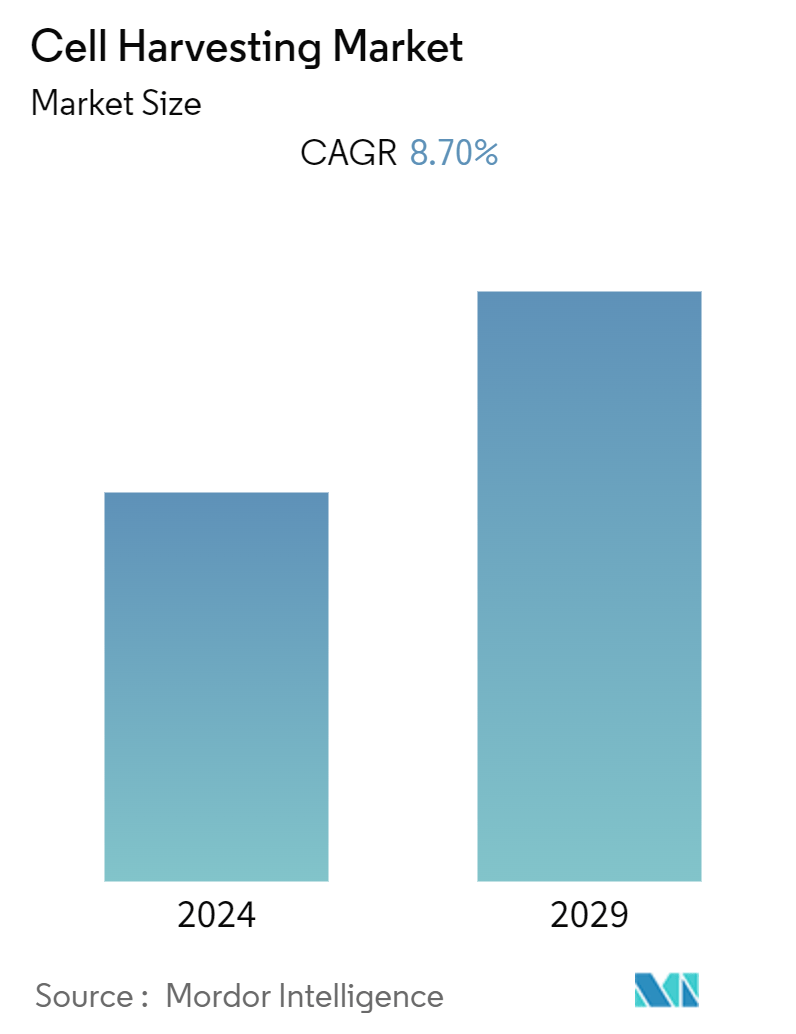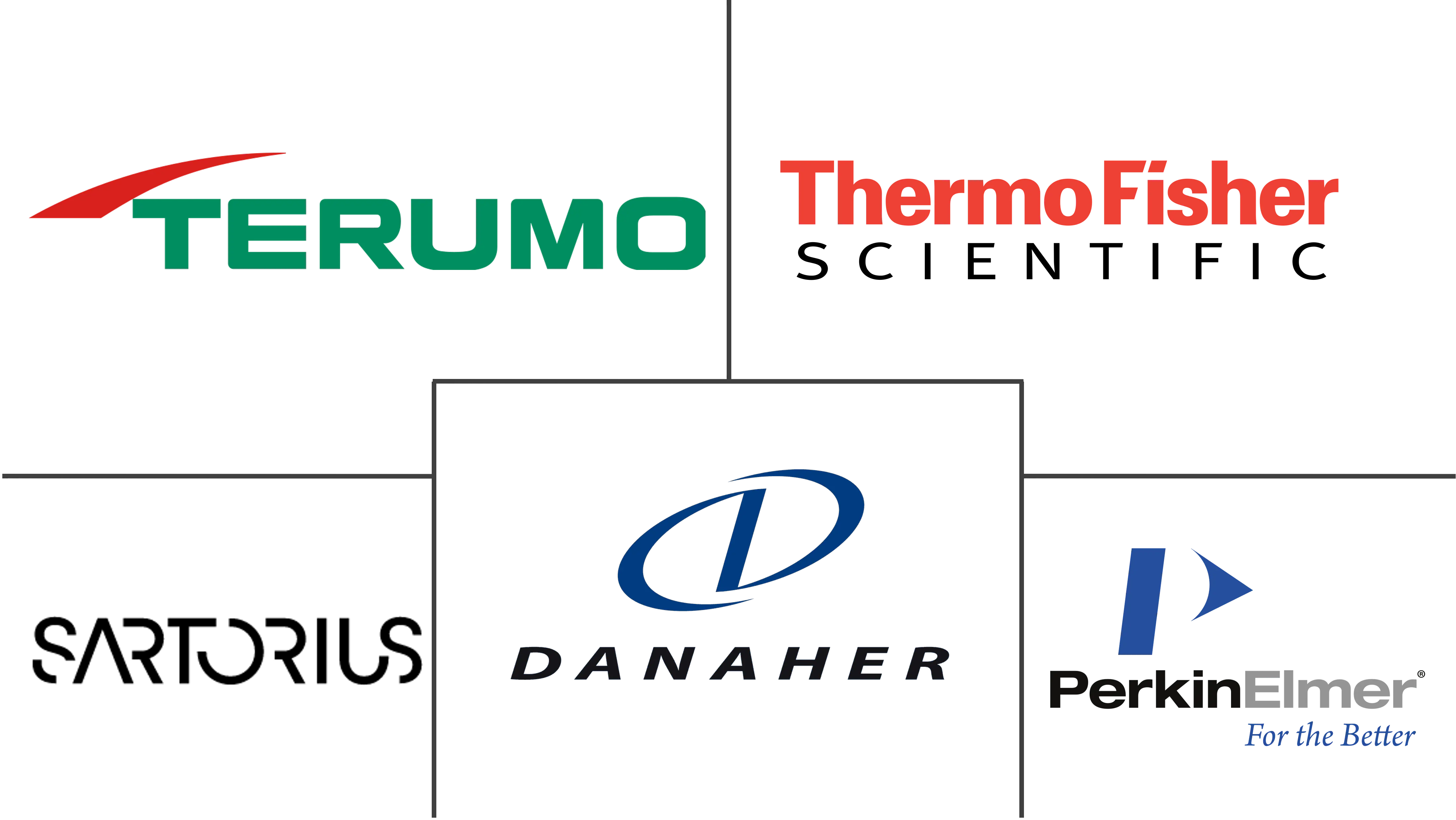Market Size of Cell Harvesting Industry

| Study Period | 2019 - 2029 |
| Base Year For Estimation | 2023 |
| CAGR (2024 - 2029) | 8.70 % |
| Fastest Growing Market | Europe |
| Largest Market | North America |
| Market Concentration | High |
Major Players
*Disclaimer: Major Players sorted in no particular order |
Cell Harvesting Market Analysis
The Cell Harvesting Market is expected to register a CAGR of 8.70% during the forecast period.
Factors such as rising investments in regenerative medicines and cell-based research are expected to boost market growth. In addition, with the increasing incidence of chronic and infectious diseases and the growing biotechnology and biopharmaceutical industries, the market studied is expected to grow over the forecast period.
Growing government initiatives to accelerate the research and development of regenerative medicine and cell therapy are expected to increase the demand for cell harvesters to reduce the time and cost of cell harvesting. For instance, in February 2022, the Government of India assisted in establishing state-of-the-art stem cell research facilities in 40 premier medical research and educational institutes to promote the study and development of regenerative medicine in the nation. Hence, establishing new research facilities increases the need for cell harvesting equipment, which is anticipated to boost market growth.
Furthermore, the increasing incidence of chronic and infectious diseases among the population raises the need for effective biotechnology-based products or regenerative medicines such as Luxturna and Zolgensma. This is anticipated to boost the demand for cell harvesters, propelling the market’s growth. For instance, as per 2024 statistics published by the Alzheimer's Association, 6.9 million people are living with Alzheimer's in America in 2024, and this number is projected to reach 13.8 million by 2060.
Additionally, according to an article published in BMJ Global Health in March 2022, spinal muscular atrophy (SMA) affects approximately 250-300 newborns in Brazil every year. Thus, the high burden of chronic disease among the population is anticipated to increase the country's focus on developing advanced cell therapy drugs, thereby bolstering market growth.
Moreover, rising product launches by companies increase the availability of advanced cell harvester systems in the market, thereby contributing to the growth of the cell harvesting market. For instance, in June 2022, researchers from the University of Technology Sydney (UTS), in collaboration with Regeneus, a biotech company, developed one of the first 3D-printed microfluidic stem cell harvesting systems. The microfluidic device is designed to collect stem cells from bioreactors, providing an affordable and scalable way to handle stem cells.
Therefore, the market studied is anticipated to grow over the forecast period due to a high burden of chronic diseases, growing biotechnology and biopharmaceutical companies, and rising investments. However, ethical issues about embryonic stem cell research are likely to hinder the growth of the cell harvesting market over the forecast period.
Cell Harvesting Industry Segmentation
As per the report's scope, cell harvesting is a technique for collecting different types of cells on the cultural surface. Multiple cell harvesting methods, such as centrifugation, filtration, microfiltration, cell separation, and T-cell culture, are used depending on the types of samples and experiments. Cell harvesting is considered an important operation that involves the removal of cells, cell debris, and other soluble and insoluble impurities that are detrimental to the subsequent chromatographic separation process.
The cell harvesting market is segmented by type of cell harvesting, application, end user, and geography. By type of cell harvesting, the market is segmented into manual cell harvesters and automated cell harvesters. By application, the market is segmented into biopharmaceutical applications, stem cell research, and other applications. By end user, the market is segmented into biotechnology and biopharmaceutical companies, research institutes, and other end users. By geography, the market is segmented into North America, Europe, Asia-Pacific, the Middle East and Africa, and South America. The report also covers the estimated market sizes and trends for 17 countries across major regions globally. The report offers the market sizes and forecasts in value (USD) for the above segments.
| By Type of Cell Harvesting | |
| Manual Cell Harvesters | |
| Automated Cell Harvesters |
| By Application | |
| Biopharmaceutical Application | |
| Stem Cell Research | |
| Other Applications |
| By End User | |
| Biotechnology and Biopharmaceutical Companies | |
| Research Institutes | |
| Other End Users |
| Geography | ||||||||
| ||||||||
| ||||||||
| ||||||||
| ||||||||
|
Cell Harvesting Market Size Summary
The cell harvesting market is poised for significant growth, driven by increasing investments in regenerative medicines and cell-based research. The market's expansion is further supported by the rising incidence of chronic and infectious diseases, alongside the burgeoning biotechnology and biopharmaceutical industries. Government initiatives aimed at accelerating research and development in regenerative medicine and cell therapy are expected to boost demand for cell harvesters, enhancing efficiency and reducing costs. The market's growth trajectory was influenced by the COVID-19 pandemic, which highlighted the potential of cell therapies in modulating immune responses, thereby increasing the adoption of stem cells in treatment protocols. However, ethical concerns surrounding embryonic stem cell research may pose challenges to market expansion.
North America is anticipated to hold a substantial share of the cell harvesting market, fueled by significant investments in regenerative medicines and the presence of key industry players. The region's market growth is further bolstered by the rising prevalence of chronic diseases and the increasing focus on stem cell research for therapeutic applications. Strategic business activities, such as collaborations and investments, are expected to enhance the availability of regenerative medicines and cell-based products. The market is characterized by a few dominant players, with ongoing product innovations, such as Thermo Fisher Scientific's DynaSpin Single-Use Centrifuge system, contributing to the advancement of cell harvesting technologies. These factors collectively indicate a robust growth outlook for the cell harvesting market over the forecast period.
Cell Harvesting Market Size - Table of Contents
-
1. MARKET DYNAMICS
-
1.1 Market Overview
-
1.2 Market Drivers
-
1.2.1 Rising Investments in Regenerative Medicine and Cell-based Research
-
1.2.2 Growth of the Biotechnology and Biopharmaceutical Industries
-
1.2.3 Increasing Incidences of Chronic and Infectious Diseases
-
-
1.3 Market Restraints
-
1.3.1 Ethical Issues Pertaining to Embryonic Stem Cell Research
-
-
1.4 Porter's Five Forces Analysis
-
1.4.1 Threat of New Entrants
-
1.4.2 Bargaining Power of Buyers/Consumers
-
1.4.3 Bargaining Power of Suppliers
-
1.4.4 Threat of Substitute Products
-
1.4.5 Intensity of Competitive Rivalry
-
-
-
2. MARKET SEGMENTATION (Market Size by Value - USD)
-
2.1 By Type of Cell Harvesting
-
2.1.1 Manual Cell Harvesters
-
2.1.2 Automated Cell Harvesters
-
-
2.2 By Application
-
2.2.1 Biopharmaceutical Application
-
2.2.2 Stem Cell Research
-
2.2.3 Other Applications
-
-
2.3 By End User
-
2.3.1 Biotechnology and Biopharmaceutical Companies
-
2.3.2 Research Institutes
-
2.3.3 Other End Users
-
-
2.4 Geography
-
2.4.1 North America
-
2.4.1.1 United States
-
2.4.1.2 Canada
-
2.4.1.3 Mexico
-
-
2.4.2 Europe
-
2.4.2.1 Germany
-
2.4.2.2 United Kingdom
-
2.4.2.3 France
-
2.4.2.4 Italy
-
2.4.2.5 Spain
-
2.4.2.6 Rest of Europe
-
-
2.4.3 Asia-Pacific
-
2.4.3.1 China
-
2.4.3.2 Japan
-
2.4.3.3 India
-
2.4.3.4 Australia
-
2.4.3.5 South Korea
-
2.4.3.6 Rest of Asia-Pacific
-
-
2.4.4 Middle East and Africa
-
2.4.4.1 GCC
-
2.4.4.2 South Africa
-
2.4.4.3 Rest of Middle East and Africa
-
-
2.4.5 South America
-
2.4.5.1 Brazil
-
2.4.5.2 Argentina
-
2.4.5.3 Rest of South America
-
-
-
Cell Harvesting Market Size FAQs
What is the current Cell Harvesting Market size?
The Cell Harvesting Market is projected to register a CAGR of 8.70% during the forecast period (2024-2029)
Who are the key players in Cell Harvesting Market?
Perkin Elmer Inc., Sartorius AG, Terumo Corporation, Danaher Corporation and Thermo Fisher Scientific Inc. are the major companies operating in the Cell Harvesting Market.

